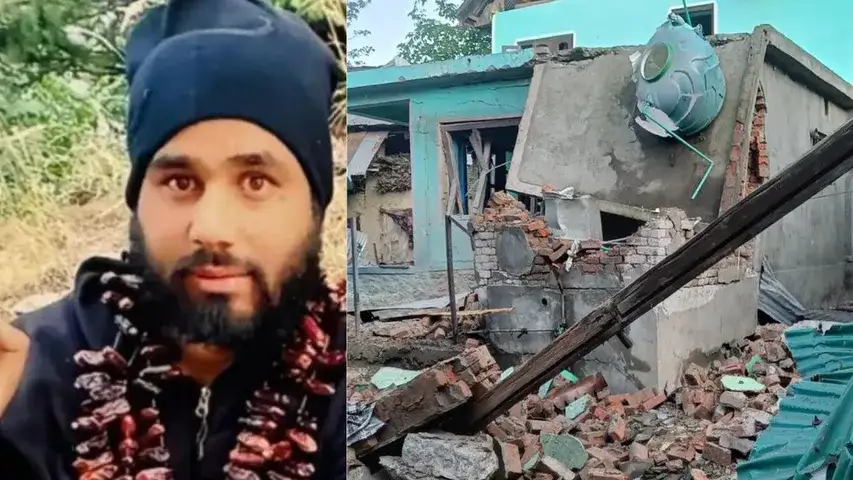Houses of Lashkar Terrorists Behind Pahalgam Attack Demolished in South Kashmir
In a strong response to the recent deadly terror attack in Pahalgam, security forces demolished the houses of two Lashkar-e-Taiba (LeT) terrorists who orchestrated the massacre that claimed 26 lives. The operation took place in South Kashmir’s Anantnag district, where the terrorists had operated and received local support.

The tragic incident unfolded on Tuesday in the scenic Baisaran area of Pahalgam, a popular tourist destination nestled in the lush greenery of Jammu and Kashmir. Among the deceased were 25 tourists from different parts of India and one foreign national from Nepal. Additionally, a local resident of Pahalgam also lost their life in the attack, which shocked the entire region and drew widespread condemnation.
How the Attack Unfolded
According to eyewitnesses and security officials, the terrorists opened fire indiscriminately on a group of tourists who had gathered in Baisaran to enjoy the picturesque landscape. The sudden ambush left little time for the victims to react, causing chaos as people ran for cover. Tragically, some victims died on the spot, while others succumbed to their injuries on the way to hospitals in Anantnag and Srinagar.
In response, local police and paramilitary forces quickly arrived at the scene and launched a large-scale combing operation in the nearby forest areas to track down the attackers. To aid in the search, drone surveillance and sniffer dogs were deployed, and security forces set up several checkpoints along exit routes. As a result, they managed to narrow down the suspects.
Identification of the Terrorists
Within 24 hours, intelligence inputs and technical surveillance led to the identification of two LeT terrorists who had planned and executed the attack. Both militants were local recruits from South Kashmir. While authorities have yet to release their names, sources confirmed their affiliation with the Lashkar-e-Taiba network. Consequently, the operation intensified, focusing on dismantling the infrastructure supporting such terrorists.
As a result, security forces demolished their houses as part of the government’s crackdown on terrorism and its ecosystem in the Valley. Authorities stated that the homes had sheltered terrorists and stored arms and ammunition, turning them into active hubs of militancy. This demolition, according to officials, sent a clear message: those who aid terrorists will face consequences.
Demolition as a Message
On Thursday morning, a joint team of the Jammu and Kashmir Police and security forces arrived at the villages where the terrorists lived. Following legal procedures and public announcements, they began demolishing the structures with bulldozers under heavy security. Officials explained that they took this action under the Unlawful Activities (Prevention) Act (UAPA), which allows for the attachment and destruction of properties used for terrorist activities.
“This is not just about retaliation; it’s about accountability,” said a senior police officer overseeing the operation. “People cannot allow their homes to be used as safe havens for terrorists and expect to remain innocent bystanders.”
Public Reaction and Political Response
The attack and subsequent demolition drive have sparked intense debate across Jammu and Kashmir. Many locals expressed anger and grief over the senseless killing of tourists, which they believed would harm the region’s already fragile tourism-based economy. As one hotel owner in Pahalgam pointed out, “We were just beginning to see more tourists after years of conflict. This incident has set us back again. Who will want to visit if they feel unsafe?”
Meanwhile, political leaders have reacted with a mix of condemnation and calls for peace. Lieutenant Governor Manoj Sinha called the attack a “cowardly act against innocent civilians” and assured the public that the perpetrators would face justice. National leaders also condemned the massacre. The Prime Minister expressed deep sorrow and extended condolences to the families of the victims. “Terrorism will never succeed in breaking the spirit of India,” he tweeted.
Tourism Under Threat?
Pahalgam, known for its breathtaking views and lush meadows, attracts thousands of tourists each year. It also serves as a key stop along the route of the Amarnath Yatra, a major Hindu pilgrimage that draws devotees from across India. However, following the attack, security forces have increased patrols in and around tourist destinations in the Kashmir Valley. Authorities have placed hotels, guesthouses, and transport services under heightened surveillance, and they are conducting identity checks more rigorously.
There is growing concern that such incidents could derail efforts to revive the tourism sector in Kashmir. The government had invested heavily in promoting the region as a safe and welcoming destination. Yet, Tuesday’s attack may make that a tougher sell, as potential visitors question their safety in the region. Consequently, authorities will need to take additional steps to reassure both locals and tourists of their security.
The Road Ahead
As the search for more suspects continues, security forces have intensified operations in known militant hotspots in South Kashmir. Authorities have detained several overground workers (OGWs)—individuals who support terrorist activities without directly participating in violence—for questioning. In the meantime, they continue to analyze the threat and coordinate with intelligence agencies to prevent further attacks.
The demolition of terrorist hideouts marks a shift in the government’s approach to counterterrorism in Jammu and Kashmir. While operations against militants have been ongoing for years, targeting their support systems and enablers is now being seen as equally important. Experts suggest that this two-pronged strategy—neutralizing active terrorists while cracking down on their networks—could help prevent similar attacks in the future.
For now, the region mourns the loss of innocent lives, even as efforts continue to restore a sense of safety and normalcy. Families of the victims, many of whom had come to Kashmir in search of beauty and peace, now face unimaginable grief. In conclusion, the Valley finds itself at a crossroads—between hope and heartbreak, tourism and terror. It remains to be seen whether the ongoing counterterrorism efforts will bring about long-term peace and stability or whether such attacks will continue to threaten the region’s fragile recovery.






